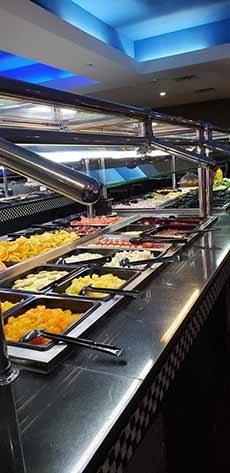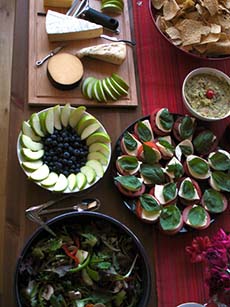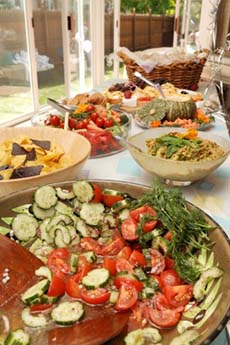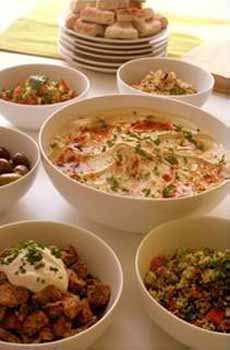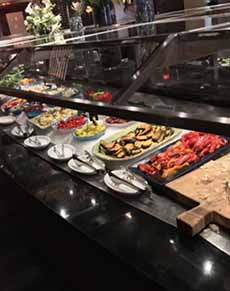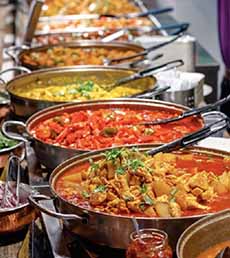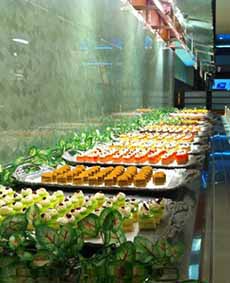TIP OF THE DAY: Plan A Buffet ~ It’s National Buffet Day
|
As if we haven’t eaten enough from Thanksgiving through New Year’s Day, National Buffet Day is held on January 2. Why, oh why??? The good news is that it is easy to have a low-calorie buffet; more about that below. The word “buffet” came to the U.S. from a French sideboard, a long, narrow, high table traditionally used in the dining room for serving food, for displaying serving dishes, and underneath, for storage of plates, flatware, etc. The use of the word expanded from home furnishings to elaborate tables of food at restaurants. (The first restaurant as we know it is believed to have been established in Paris in 1765 by one A. Boulanger, a soup vendor.) We unabashedly love buffets. Our favorite meal is a little bit of many foods, and we often serve party buffets at home (there’s a list of them below). A bonus: We don’t spend the entire dinner hour jumping up from table to kitchen. A good buffet is food-lover excitement. In our home town (New York City), we can head to* buffets that focus on different cuisines: But a buffet doesn’t have to be high in calories, especially the ones you prepare at home. The board will be growing with even half of these recipe ideas. In alphabetical order, consider: We’ve included party bars in this list: a table of ingredients that guests customize for themselves. Like salad bars†, the base ingredient is provided with numerous options for add-ons. THE HISTORY OF THE MODERN BUFFET The Swedish are credited with popularizing the modern buffet in the U.S. At the 1939 World’s Fair in New York City, the restaurant at the Swedish Pavilion’s restaurant, Three Crowns, featured a smörgåsbord—a large help-yourself selection of some of the best hot and cold Swedish dishes. In restaurant terms, for a fixed sum, guests could help themselves as many and as much as they want from a table of abundant choices. During the second half of the 20th century, the smörgåsbord—which had been referred to as a “buffet” by the American media—grew popular in the U.S. Restaurants debuted buffet-style lunches and dinners with multiple hot and cold dishes, set up on a long table. Diners helped themselves to whatever they liked. The idea extended into homes, too: certainly, our grandmother and mother entertained with buffets. But centuries before then, in the U.S., the concept began at taverns and inns with the “groaning board,” or simply “board” or sideboard—a piece of furniture that held victuals for guests to help themselves. Those victuals were, in most cases, just the basics: meat, potatoes, bread, butter, soup. Across the pond in Scandinavia, however, the Brännvinsbord anticipated the evolution of the modern buffet. During the middle of the 16th century, the Brännvinsbord emerged as a Scandinavian meal concept. In Sweden and Finland, the merchant and upper classes served a schnapps table (brännvinsbord), a small buffet placed on a side table to accompany brandy or liqueurs as a mid- or late-afternoon refreshment of schnapps or brandy (the difference). In more affluent homes, foreign spirits such as cognac and whiskey might also be served. This pre-dinner nibble was somewhat analogous to the modern American Happy Hour buffet or cocktail hour. As a way to stave off hunger prior to dinner, it could be compared to the English custom of afternoon tea (with alcohol instead of tea). The Russian tradition of zakuski is a variation of the brännvinsbord. The Brännvinsbord was set up on a side table where guests gathered for a pre-dinner drink. It was separate from the formal dinner that followed; and could occur from two to five hours before dinner itself. The sideboard traditionally held five types of food: By the 18th century the concept had become quite popular; but the old concept was at the cusp of peaking and expanding. Around the beginning of the 19th century, it developed into a more extensive buffet—or in Scandinavia, the modern smörgåsbord. During the expansion of the European railroads throughout Europe, after 1830, the smörgåsbord buffet increased even more in popularity. During the 1912 Olympic Games held in Stockholm, restaurants stopped serving smörgåsbord as an appetizer and began to serve it as a main course [source]). |
|
|
|
With enthusiastic mention by the media, smörgåsbord became known throughout the world. The word often used was buffet, which was much easier to pronounce and remember in the English-speaking world. Jump to the U.S. in the 1940s. The American version of smörgåsbord, the buffet, began in Las Vegas at the Buckaroo Buffet restaurant Today, Las Vegas may be the buffet capital of the world, with its famous all-you-can-eat buffets at major hotels, with seeming endless choices, including desserts. The 1980s, large chain restaurant buffets emerged: Golden Corral, Hometown Buffet, Old Country Buffet, Pizza Hut, Ryan’s, Sizzler, Souplantation and Sweet Tomatoes. Mom and Pop buffets followed. In 1997, the upscale Fogo de Chao Brazilian steakhouse chain opened its first U.S. location 1997 (it now has has 57 locations worldwide). It’s buffet heaven: an immense salad bar of top-quality items accompanies unlimited beef, lamb, pork and poultry carved for you from skewers at tableside. According to Business Review at Berkeley, an independent student-run website, even before Covid the buffet concept was in trouble. They claim that: *This article was written during the Covid restaurant shut-down, and refers to happier times—with hopes for return to normalcy. †There are different levels of “salad bars.” Some may just have salad ingredients. Others expand the concept with cheeses, meats, seafood and more.
|
||

